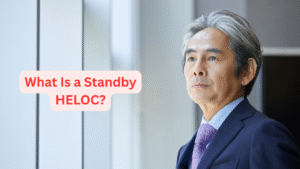 What Is a Standby HELOC? Your Hidden Financial Safety Net
What Is a Standby HELOC? Your Hidden Financial Safety Net
In today’s uncertain world, financial flexibility is more valuable than ever. One tool homeowners can use to create a personal safety net is a Standby HELOC—a Home Equity Line of Credit that remains open and available, even if it’s never used. Think of it as a financial lifeline: invisible until you need it, but powerful when emergencies arise.
In this blog post, we’ll explore what a Standby HELOC is, how it works, its benefits, risks, and whether it might be a smart move for your financial planning.
Understanding a Standby HELOC
A Standby HELOC is a traditional home equity line of credit that is set up but not drawn upon immediately. In other words, the account exists, the funds are available, but you’re not actively using the money. It’s kept in “standby” mode until you need it.
Unlike a personal loan or lump-sum home equity loan, a HELOC is revolving credit—similar to a credit card. You have a set borrowing limit, and you can draw from it when needed, repay it, and borrow again during the draw period. The key distinction with a standby HELOC is you don’t use the funds unless a situation arises where you need quick access to cash.
How Does a Standby HELOC Work?
When you apply for a HELOC, a lender will evaluate the amount of equity in your home, your credit score, income, and debt-to-income ratio. Based on those factors, they’ll approve you for a line of credit—usually up to 85% of your home’s appraised value, minus what you still owe on your mortgage.
Once the HELOC is in place, you can:
- Access the funds anytime during the draw period (usually 5 to 10 years)
- Only pay interest on the amount you borrow
- Leave the balance at zero if you don’t use the funds
Since a standby HELOC remains unused initially, you pay little to nothing unless you draw from it. However, some lenders may charge a small annual or inactivity fee.
Benefits of a Standby HELOC
1. Peace of Mind in Emergencies
Life can throw unexpected curveballs: medical emergencies, job loss, or urgent home repairs. A standby HELOC offers quick access to cash without needing to reapply or wait for loan approval.
2. No Interest Until You Borrow
You won’t owe any interest on the unused funds. If the balance is zero, your interest charges are zero—making it a very cost-effective safety net.
3. Lower Rates Than Credit Cards
HELOC interest rates are typically much lower than credit card rates, especially for those with good credit. In times of need, a HELOC is a more affordable way to borrow.
4. Boosts Financial Flexibility
Having available credit can be helpful in seizing financial opportunities, such as investment real estate deals, small business funding, or even bridging a temporary cash shortfall.
5. May Improve Credit Score
Unused but available credit can improve your credit utilization ratio, a major factor in credit scores. As long as you manage it responsibly, a standby HELOC could enhance your credit profile.
Risks and Considerations
While standby HELOCs offer valuable flexibility, they are not without risk.
- Your home is collateral: Failing to repay any borrowed amount could lead to foreclosure.
- Variable interest rates: HELOCs often have variable rates, which can rise over time.
- Lender fees: Some banks charge maintenance or inactivity fees even if the funds aren’t used.
- Expiration of draw period: If you don’t use the HELOC during the draw period, it may close or convert to a repayment phase.
Before setting one up, review all terms and compare lenders carefully.
Who Should Consider a Standby HELOC?
A standby HELOC is ideal for homeowners who:
- Have significant equity in their home
- Want access to emergency funds without dipping into savings
- Are self-employed or have irregular income
- Want to fund home improvement projects on an as-needed basis
- Prefer a proactive approach to financial planning
It’s especially useful for retirees or individuals nearing retirement, as it offers a fallback option without requiring regular income to qualify in a pinch.
Final Thoughts
A Standby HELOC is like a financial fire extinguisher—you hope you never need it, but you’ll be glad it’s there if things go wrong. By setting one up while your income and credit are in good standing, you can ensure access to affordable credit down the road.
If you’re a homeowner looking to create a safety net or maintain liquidity for unexpected situations, a standby HELOC might be a strategic move. Just make sure to compare fees, interest rates, and lender terms before signing on the dotted line.
FAQs: Standby HELOCs
1. Is a standby HELOC the same as a regular HELOC?
Yes, it’s the same product, but it’s kept at a zero balance and used only in emergencies or special circumstances.
2. Does a standby HELOC affect my credit score?
It can positively affect your score by improving your credit utilization ratio, as long as it’s managed responsibly.
3. Are there any fees if I don’t use the HELOC?
Some lenders charge annual maintenance or inactivity fees, so check the terms before opening the account.
4. How long does a standby HELOC stay open?
The draw period typically lasts 5–10 years, after which repayment begins or the account may close.
5. Can I be denied a HELOC later if I wait to apply?
Yes. If your credit score drops or your income changes, you might not qualify in the future. That’s why many people set it up in advance.